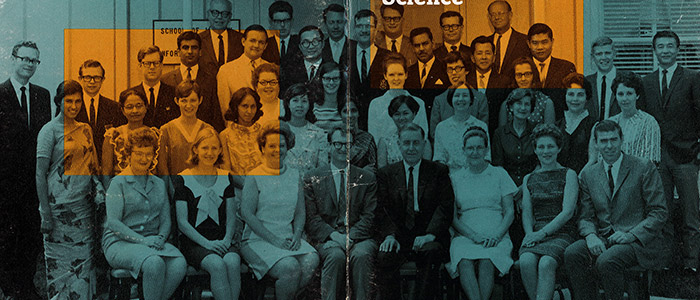FIMS News
Contact Information
FIMS Communications
Becky Blue
Email
519-661-2111x88493
FIMS & Nursing Building
Rm 2060C
Fifty years of Library and Information Science
 Librarians know that they have much to offer a contemporary society that is brimming with endless information and information sources.
Librarians know that they have much to offer a contemporary society that is brimming with endless information and information sources.In 2016, the need for people who know how to manage large amounts of information, whether in library systems, branches of government, private enterprise, or any number of other possibilities, continues to grow. New areas of expertise in information management, policy, consultation and research have emerged. The skills that fuel that expertise, developed initially through traditional librarianship, have always been transferable, and those skills are essential to an informed, democratic citizenry.
It’s no surprise, then, that 50 years into Library and Information Science (LIS) at Western, the discipline finds itself a vital component of the Faculty of Information and Media Studies (FIMS). In a faculty where interdisciplinarity and scholarly crossover is an ever-evolving goal, LIS graduate students and faculty form an engaged community who lend their ideas and expertise to colleagues and peers in media studies, journalism and communications, as well as the more recent Health Information Sciences program.
More than 6,500 Master of Library Science or Master of Library and Information Science students have passed through the program since its inception. The number of doctoral alumni is approaching 100.
An academic program with this kind of breadth can’t exist for 50 years without weathering numerous changes, and LIS at Western has experienced several twists and turns during its history. There are a number of staff and faculty still working in FIMS who recall the early days, either from personal experience or through stories, and they’ll be the first to describe how different things are now.
 Founded in 1966 as the School of Library and Information Science (SLIS), the school opened to address a reported shortage of professional librarians in Canada. Programming got underway with 40 full-time and 20 part-time students.
Founded in 1966 as the School of Library and Information Science (SLIS), the school opened to address a reported shortage of professional librarians in Canada. Programming got underway with 40 full-time and 20 part-time students.“It was founded to be very, very experimental, and to try all sorts of interesting things,” says Professor Lynne McKechnie, who arrived as a doctoral student in 1990, but who is aware of much of the history. She recalls a number of initiatives unique to SLIS at Western, including a library that was unlike any other.
“What we had was an experimental classification system. It was not Dewey class, it was not Library of Congress, which is what’s used in most university collections. It was its own system. And as part of their learning process, the students actually classified and catalogued all the materials that came into the library,” McKechnie says.
“The whole idea was to say, ‘let’s throw out these things, and we’ll use this as a mechanism to look critically at our standard classification systems’. The whole library at that time was viewed as a living, learning lab.”
McKechnie recalls that classes were also taught in seminar style, which meant that students were primarily doing the teaching with the instructors acting as more of a coach. The workload that accompanied this method was imposing. Students were required to write up to five short seminar papers each week, to prepare for their classes. No other library school was teaching in this way.
Though teaching methods have changed since then, and the current Graduate Resource Centre Library no longer employs a unique classification system, McKechnie notes that much of the history of this early period in library science at Western is preserved by Western Libraries, including many of the short seminar papers.
“University Archives here (at Western) has a remarkable collection which shows the early history of the school,” she says.
In 1985, the school adjusted to changes that were being driven by computers and technology by shifting to the new Master of Library and Information Science degree, which replaced the traditional Master of Library Science. There was a brief name change between 1993 and 1995, when the School of Library and Information Science became the Graduate School of Library and Information Science. People who were on hand at that time will likely better remember it by its acronym GSLIS. Both SLIS and GSLIS are still occasionally heard mentioned in the halls of North Campus Building today.
Scholarly research was also becoming increasingly important during this time, as the doctoral program had been accepting students since the late ‘70s. Whereas the school had primarily operated with professional instructors in the early days, tenured professors were now entering the ranks, and bringing with them a variety of academic research focuses.
What was perhaps the most significant change for the school came in 1996, when it joined with Western’s School of Journalism and the Faculty of Part-Time and Continuing Education to form the Faculty of Communication and Open Learning (soon renamed the Faculty of Information and Media Studies).
At that time, plans were underway to create a new, innovative undergraduate program that could respond to the emerging need for people who understood media in its many complexities – professionally, critically, and theoretically. The program was named Media, Information and Technoculture (MIT).
MIT was unique in the mid-to-late ‘90s, and the LIS program was expected to play a large role in its development and delivery. Along with personnel from the former School of Journalism, as well as help and direction from Carole Farber, who had been the Dean of the Faculty of Part-Time and Continuing Education, LIS served as one of the seed programs for an undergraduate program that is now home to over 1,000 students.
“The hope was that scholars and scholarship in library and information science would bring to the Media, Information and Technoculture program that understanding of the organization of information and the use of information,” explains Jacquie Burkell, the current Assistant Dean of Research for FIMS, when asked about the merging of LIS with journalism.
“The programs came together because they’re both about information. And LIS was dealing with issues of information policy, of information technology, and behaviour around technology. We may come and go from those particular areas, but really those are fundamentally the three things that we’re doing.”
LIS faculty members taught some of the earliest core courses in MIT and continue to contribute to the curriculum today. For example, MIT 2157 – Planet Google: Big Data and Information Society, taught by LIS faculty member Grant Campbell, “is a course based on Grant’s understanding of knowledge organization, based on his understanding of searching and search skills. It’s just translated into a slightly different form for MIT students,” says Burkell.
The benefits of the merger were not intended to be one-way, however. Burkell says that contact with professional journalists, as well as arriving media scholars, meant that LIS faculty were regularly exposed to a much broader array of media perspectives which bolstered their understanding of the modern media and information landscape. This exposure gave the LIS program a leg-up in reacting to changes over time, so that both the curriculum and research could continue to evolve. “I think the challenge for Library and Information Science as a discipline is to encompass new ideas about information and information organization. The way that information is organized and the way that it’s distributed. So we’ve had to very actively move our models from beyond libraries into distribution in other ways,” explains Burkell.
“I think the challenge for Library and Information Science as a discipline is to encompass new ideas about information and information organization. The way that information is organized and the way that it’s distributed. So we’ve had to very actively move our models from beyond libraries into distribution in other ways,” explains Burkell.
“We have had to think about the ways in which our skills and knowledge apply in information-seeking and information use in a completely different context where maybe you don’t have that tight relationship between the information professional and the person who’s seeking information, but instead you have to think about that action at a distance.”
The creation of MIT in 1996/97 was not the last time that LIS would lend its expertise to another discipline. In 2011, LIS faculty member Nadine Wathen helped found the joint graduate program in Health Information Science in partnership with the Faculty of Health Sciences.
Offering both a master’s level degree and a PhD, the HIS program aims to graduate health information specialists and scholars who are committed to both theory and research in the emerging area of health information science. Students should graduate with fundamental knowledge in public health, health policy, knowledge organization, knowledge translation and ethics. They are encouraged to draw on expertise from across both FIMS and Health Sciences.
The program has already graduated seven master’s level students, and has a number of doctoral students working to complete their degrees.
If you ask Lynne McKechnie today about the evolution of LIS at Western, she will say that though many things have indeed changed, other things also remain the same. According to McKechnie, the fundamental skills taught in library and information science remain the same, regardless of how they are employed out in the world. And in fact the core courses that continue to be taught at all the library schools have stayed relatively stable.
“I think the core skills remain the same. They just play out differently. And that’s reflected,” she says, adding that people themselves are same in many ways.
“Some things don’t change. When people want to know something they ask someone they trust. That is so fundamental.”
With these core strengths in place, library and information science will move into the future with hopes of continuing to provide excellent educational opportunities for students, as well as continuing to engage in meaningful scholarly research.
With the move into the brand new FIMS & Nursing Building in December 2016, the LIS program will experience its fourth relocation. But for many personnel, home is where you hang your hat, and the good work will simply continue.
Also see: Staff and student library assistants from the Graduate Resource Centre Library have been working on a Wikipedia page detailing the history of LIS at Western.
By FIMS Communications


